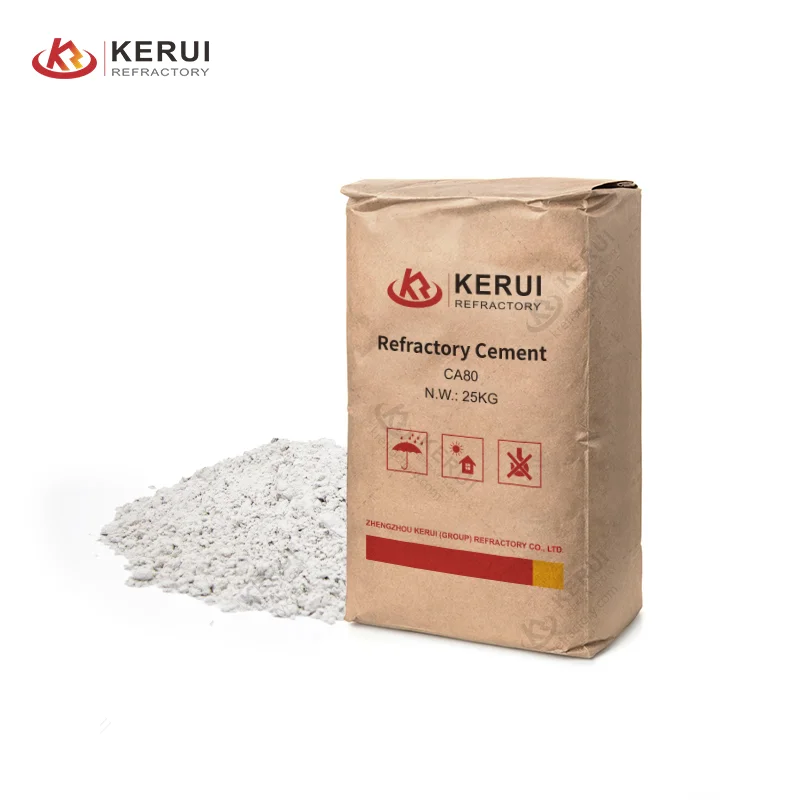Article Navigation
- Basic Definitions
- Composition & Manufacturing
- Technical Performance Comparison
- Application Scenarios
- Selection Guidelines
1. Basic Definitions
1.1 Refractory Mortar (Refractory Mud)
- Definition: A workable paste used to bond refractory bricks, composed of fine refractory aggregates and a bonding agent.
- Primary Role: Fills joints between bricks (1–3mm) and ensures structural integrity.



1.2 Refractory Cement (Calcium Aluminate Cement)
- Definition: A hydraulic binder containing 35–80% Al₂O₃, which hardens when mixed with water.
- Primary Role: Base material for refractory castables or repair mortars in monolithic linings.



2. Composition & Manufacturing
| Component | Refractory Mortar | Refractory Cement |
|---|---|---|
| Aggregates | 60–80% (calcined clay, chamotte) | None (pure binder) |
| Binder | 10–30% (sodium silicate, phosphates) | 100% calcium aluminate clinker |
| Additives | Plasticizers, anti-shrink agents | Grinding aids, set modifiers |
| Particle Size | <1mm (for joint filling) | Powder (<200 mesh) |
3. Technical Performance Comparison
| Parameter | Refractory Mortar | Refractory Cement | Test Standard |
|---|---|---|---|
| Max Service Temp | 1,300–1,450°C | 1,400–1,600°C | ASTM C113 |
| Cold Crushing Strength | 10–25 MPa | 30–80 MPa | ASTM C133 |
| Thermal Conductivity | 0.8–1.5 W/m·K | 1.2–2.0 W/m·K | ASTM C201 |
| Setting Time | Air-dries (no hydration) | 1–4 hours (hydration) | ASTM C191 |
| Bonding Strength | 1–3 MPa | 5–15 MPa | ASTM C198 |
4. Application Scenarios
4.1 Refractory Mortar Applications
- Brick Joints: Bonding firebricks in pizza ovens, kilns, and boilers.
- Repairs: Patching small cracks (<5mm) in existing brick linings.
- Insulation Backing: Sealing gaps behind ceramic fiber modules.
4.2 Refractory Cement Applications
- Castable Linings: Mixing with aggregates (e.g., bauxite, SiC) to pour furnace floors/walls.
- Anchoring Systems: Securing ceramic fiber blankets with cement-based adhesives.
- High-Temperature Repairs: Rebuilding eroded areas in kiln transition zones.
5. Selection Guidelines
5.1 Choose Refractory Mortar When:
- Working with pre-fired bricks (e.g., insulating firebricks).
- Joint thickness is ≤3mm.
- No water exposure is expected during curing.
5.2 Choose Refractory Cement When:
- Constructing monolithic linings (e.g., castables).
- Rapid setting (<2 hours) is required.
- High mechanical strength (CCS >30 MPa) is critical.
5.3 Kerui’s Solutions
- Kerui Refractory Mortar: Low-iron formula (Fe₂O₃ <1%) for Refractory brick masonry.
- Kerui Refractory Cement: 40-70% Al₂O₃.
Key Takeaways
- Refractory Mortar excels in bonding bricks and minor repairs but lacks structural strength.
- Refractory Cement is versatile for casting and heavy-duty repairs but requires precise water mixing.
- Kerui offers ISO 9001-certified products with tailored formulations for specific thermal and chemical challenges.
For technical datasheets or custom formulations, CONTACT US!
Data based on ASTM standards and Kerui laboratory testing. Performance may vary by application.



